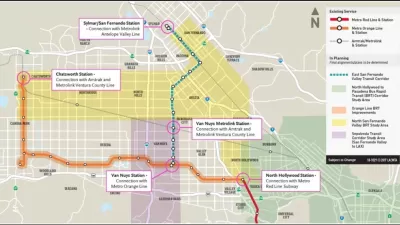The Los Angeles County Metropolitan Transportation Authority (Metro) will implement a new land banking program to mitigate gentrification and displacement around future transit lines.

“The LA Metro Board of Directors voted on Thursday, June 23 to pursue land-banking as a tool to prevent gentrification near its future transit projects,” reports Steve Scauzillo for the Los Angeles Daily News.
Scauzillo explains the land banking concept, less common in Southern California than in other parts of the country, as follows: “By buying up land early in its planning process, the mega transit agency can “bank” the property, then sell it to affordable housing developers — but with requirements that guarantee low-rents and prohibit speculation.”
As the reasoning behind the new anti-gentrification measure, Scauzillo lists two examples of transit-induced gentrification from around the Metro service, around the L Line (formerly the Gold Line) in the Highland Park neighborhood in Los Angeles and in Pasadena. With the K Line (Crenshaw/LAX) nearing completion, the concerns about transit-induced gentrification shift to historically Black and Brown neighborhoods in South L.A., prompting Metro’s new program.
“Metro is also concerned about gentrification along a planned light-rail line that would connect downtown Los Angeles to southeast L.A. County, known as the West Santa Ana Branch (named after an old Pacific Electric Line’s Santa Ana route in L.A. County),” according to Scauzillo. “It would serve the cities and communities of downtown Los Angeles, unincorporated Florence-Graham, Vernon, Huntington Park, Bell, Cudahy, South Gate, Downey, Paramount, Bellflower, Cerritos and Artesia.”
Interestingly, the Metro Board isn’t the only countywide power to launch land banking efforts in recent days. While approving a new Los Angeles River Master Plan earlier this month, the Los Angeles County Board of Supervisors allocated $50 million for land banking and identified 22 potential project sites along the 51-mile-long Los Angeles River, reports Scauzillo.
FULL STORY: LA Metro will try to prevent gentrification near its future rail lines by ‘land banking’

Maui's Vacation Rental Debate Turns Ugly
Verbal attacks, misinformation campaigns and fistfights plague a high-stakes debate to convert thousands of vacation rentals into long-term housing.

Planetizen Federal Action Tracker
A weekly monitor of how Trump’s orders and actions are impacting planners and planning in America.

San Francisco Suspends Traffic Calming Amidst Record Deaths
Citing “a challenging fiscal landscape,” the city will cease the program on the heels of 42 traffic deaths, including 24 pedestrians.

Defunct Pittsburgh Power Plant to Become Residential Tower
A decommissioned steam heat plant will be redeveloped into almost 100 affordable housing units.

Trump Prompts Restructuring of Transportation Research Board in “Unprecedented Overreach”
The TRB has eliminated more than half of its committees including those focused on climate, equity, and cities.

Amtrak Rolls Out New Orleans to Alabama “Mardi Gras” Train
The new service will operate morning and evening departures between Mobile and New Orleans.
Urban Design for Planners 1: Software Tools
This six-course series explores essential urban design concepts using open source software and equips planners with the tools they need to participate fully in the urban design process.
Planning for Universal Design
Learn the tools for implementing Universal Design in planning regulations.
Heyer Gruel & Associates PA
JM Goldson LLC
Custer County Colorado
City of Camden Redevelopment Agency
City of Astoria
Transportation Research & Education Center (TREC) at Portland State University
Jefferson Parish Government
Camden Redevelopment Agency
City of Claremont





























